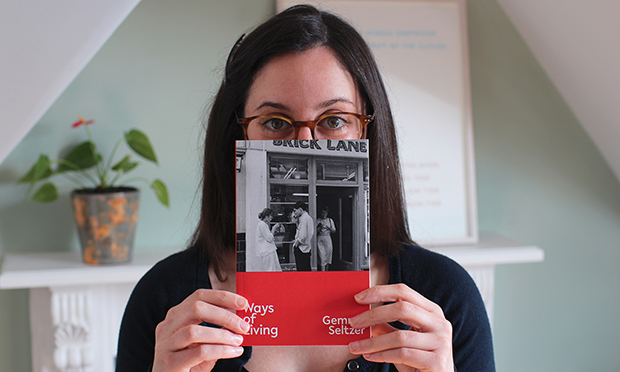‘I wanted to write about women making the city their own’: Author Gemma Seltzer on how the streets of East London influenced her new book

Recent months have been unreal in some ways but all too palpable in others. Wandering around London during the pandemic, Gemma Seltzer caught the mood and forged it into Ways of Living, a magnetic collection of short stories with a magical realist feel.
The Citizen caught up with the author to chat about the places and people in her tales.
HC: The East London you depict is at once very familiar and also very specific. Can you tell us a bit about the influences that shaped the world you portray in these stories?
GS: The city is a backdrop to my fiction. Each story in Ways of Living weaves in overheard conversations, memories and pieces of the landscape. I take inspiration from the writer Grace Paley who said, “You write from what you know but you write into what you don’t know.”
My family are from east London, a couple of generations back. My great-grandfather had a shop on Whitechapel Road. I feel a connection to the area and recently worked for a couple of years in Whitechapel. I loved spending my lunch hours walking in the streets, exploring Shoreditch, Hoxton and Haggerston. I’d look for traces of history in faded shop signage and former school buildings, the old bell foundry and gardens reclaimed by the community.
The stories in Ways of Living contain bold women who do extraordinary and strange things on London’s streets: they climb trees, abandon all their friends, and befriend ventriloquist dummies. The pieces are set in a reality you would know, with people you may meet and specific places names—like Beigel Bake and the Betsy Trotwood pub—alongside unnamed cafes and bookshops. The surreal elements take you somewhere unexpected, disorientated and not sure which path the story will take. I’m trying to offer a new perspective on familiar places and to address the complexity of how women navigate the city. For many women, there are so many layers of thoughts and fears, joys and concerns, playing out beneath the surface when they walk in London.

Photograph: Lauren Renner
The first story in the collection, for example, ‘Too Close and Not Close Enough’ begins with two school friends meeting unexpectedly in Beigel Bake as older women and retracing their childhood relationship. We slowly understand that one has taken something significant from the other. The piece uses details from my wanderings around Brick Lane: from eavesdropped conversation, the taste of cream cheese bagels, the way people talk and talk and never say what they mean to each other.
Walking is a big part of my writing process. When I’m walking, I see a stream of images—people laughing, a bird flashing by, someone disappearing around a corner—and I’m interested in how I can translate that experience into words. In a short story, I can hold these moments and stop them floating away, so I can look at them closely and show others what I see.
HC: Ways of Living has exclusively woman protagonists; what made you decide to give the stories this slant?
GS: Ways of Living is about women’s lives; how they move around the city and how their friendships are played out on the streets.
The setting for the stories is outside the home. We meet the characters in public or communal spaces such as hotels, cafes, restaurants, shops, synagogues, parks and offices. I wanted to write about women moving through the world, claiming space and making the city their own. It’s important to foreground women’s lives as we still don’t see enough representation of a broad range of women on television, in films and in books.
I feel there is a gap in literature and culture where the primary relationship depicted is female friendship. Often women’s relationships are shown in relation to men: being wives or mothers or lovers or daughters. The reality of female friendship is that it’s intense and passionate and brilliant and heartbreaking—as Jamaica Kincaid says: “Friendship is a simple thing, and yet complicated; friendship is on the surface, something natural, something taken for granted, and yet underneath one could find worlds.” I wanted to write about both the surface and the ‘underneath’ too.
The primary relationship in my stories is between the protagonists, her friends and the place she lives, works and wanders. They’re all in constant conversation.
HC: A theme that flows through many of these stories is having the courage to be different. Do you think local communities mould character traits such as this?
GS: Yes! Many of us have found our voice through exploring the city and meeting people from all over the world. Being part of a community—whether that’s in a specific building or location, a faith community or a cafe where the staff know your favourite drink—grounds you to a place. This encourages you to identify with that location, and feel a responsibility to care for it and those around you.
The history of east London is so fascinating, and constantly evolving and shifting. I think of the Whitechapel of the past, of the French Huguenots, of the Irish families, of my great- grandparents and other Jewish people like them who arrived and set up businesses and shops, set up synagogues and homes, of the Bangladeshi communities who made a life there, too. These waves of immigration bring new ideas, expand the existing culture, and can create an interconnectedness. For a writer, it’s energising as well as humbling to feel that the city is ever-moving, that you can stand on streets that have held so many different kinds of people’s hopes and experiences.
Ways of Living by Gemma Seltzer is published by Influx Press. ISBN: 978-1-910312-75-9; RRP: £7.99.
